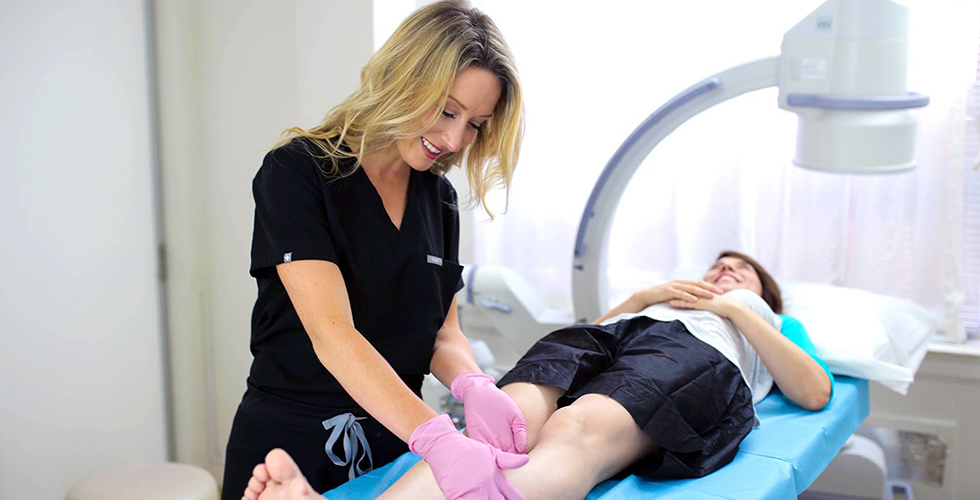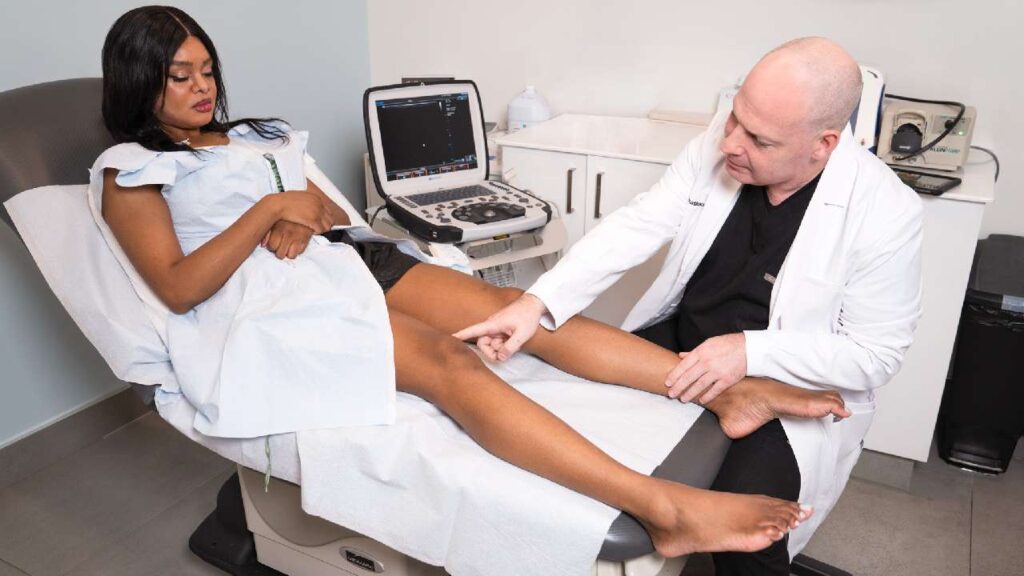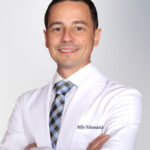Step One: Find a Board Certified Vein Doctor in New York
The first step in finding affordable vein care in New York City is choosing a board certified vein doctor. Some vein clinics are run by estheticians, cosmetic specialists, or dermatologists who didn’t study vein medicine or vascular surgery. As a result, they can only perform superficial vein treatments through the surface of the skin. These are often considered elective procedures by insurance companies, which makes them more expensive. Superficial treatments like topical lasers are also ineffective against large varicose veins. It would require so much heat to close a large vein through the skin that it would destroy the epidermis.
If you have varicose veins or spider veins in the legs, you likely need a procedure that penetrates the skin for safe and effective relief. So, choose a board certified vein specialist who can provide that level of care. Book an appointment with one of our Harvard-trained vein experts for best results. Most patients do not need surgery. Surgical vein extraction has been largely replaced by minimally invasive spider and varicose vein treatment techniques that close veins inside the body, rather than cutting them out. These are routinely covered by insurance.

Step Two: Choose a Vein Clinic That Accepts Your Insurance
Once you’ve selected a qualified vein doctor, inquire about their insurance coverage. Vein clinics that don’t accept insurance are probably not run by vein doctors. Vein treatment is now covered by most carriers if the procedure is deemed medically necessary. Insurance wording can be intentionally confusing for patients. But our insurance experts are adept at acquiring the coverage you deserve. We file all paperwork on your behalf, and you’ll know what amount you owe before you arrive for treatment. Most of our patients have no out-of-pocket expenses for their spider or varicose vein treatment.
It’s important to choose New York vein centers that offer a variety of procedures. Some insurance plans don’t cover every treatment equally, so this ensures that you have options to choose from. Certain companies require their subscribers to try compression stockings before they’ll cover treatment for spider veins or varicose veins. If this applies to you, our vein doctors can provide the right stockings and document your experience to help you achieve coverage. Our vein doctors have an additional skill to help many patients skip this step. They are trained in ultrasound-guided tests, so they can locate the cause of superficial damage in deeper veins. They’ll produce images for your insurance carrier as evidence that your treatment is medically necessary.
Step Three: Select a Minimally Invasive Treatment
Minimally invasive treatment is often the most cost-effective way to eliminate spider vein and varicose vein damage. Treatments at the surface of the skin aren’t powerful enough for many unhealthy veins, and they’re rarely covered by insurance. Surgical treatments are costly and overly invasive for most vein issues. Minimally invasive procedures fall between surface and surgical treatments in terms of invasiveness. They provide the right level of attention to treat the vein safely and effectively, without the risks and recovery associated with surgery.
Minimally invasive vein treatments are also the most permanent solution. A surface laser might only fade the vein, but it can reappear. A surgical treatment can result in the vein growing back as part of the body’s healing process. But a minimally invasive treatment closes the vein inside the body, rather than fading it or cutting it out. Once a blood vessel is successfully sealed, it can’t grow back. It’s harmlessly absorbed by surrounding tissue, and blood is rerouted into healthy veins nearby. The efficacy of these treatments helps prevent the cost of additional treatments in the future.
You can choose from sclerotherapy (Asclera or Varithena), mechanochemical ablation (ClariVein), radiofrequency ablation (ClosureFast), vein adhesives (VenaSeal), or a combination of procedures for flawless results. For instance, if you have both spider veins and varicose veins, our doctors might inject the small spider veins with a liquid sclerosant (Asclera), and the large varicose veins with a foam sclerosant (Varithena). Our treatments are all performed in-office without general or spinal anesthesia. They take about 15 to 30 minutes, and you can walk around right after vein treatment. You can even drive yourself to the appointment and go back to work afterward, if you wish. These gentle procedures eliminate the stress of lost wages from work. There is no downtime required, other than a brief break from overly strenuous exercise.
Step Four: Treat the Cause Beneath the Surface of the Skin
Since superficial vein damage often stems from issues in deeper veins, finding the cause is part of affordable vein care. If you have Chronic Venous Insufficiency, which involves faulty vein valves and weakened vein walls, you can expert more spider veins and varicose veins to develop until you address it. Some patients think their vein damage has returned after treatment, when in fact, new defective blood vessels have formed in the same area from the unaddressed cause.
This is another reason to choose a board certified vein specialist with the technology to observe what’s happening beneath the surface of the skin. Our vein experts use Duplex and Doppler Ultrasound and conduct vein mapping tests to find blockages, sluggish blood flow, blood clots, and faulty valves within veins. They can treat Chronic Venous Insufficiency and other causes of spider veins and varicose veins with minimally invasive treatments. Closing off the causative blood vessels is essential to long-term relief from unsightly superficial veins.
Step Five: Prevent New Spider Vein and Varicose Vein Damage
Varicose veins and spider veins are common problems which aren’t entirely avoidable. They run in families, and they are prevalent in women, due to hormonal fluctuations associated with pregnancy, menopause, birth control usage, and hormone replacement therapy. They’re common in men as well, especially as they age, since vein walls become stretched and weakened over time.
But there are certain things you can do to minimize your risk of developing new spider and varicose veins. Maintain a healthy weight and active lifestyle. Avoid long periods of sitting or standing without taking breaks to move around. Elevate your legs above heart level while relaxing. And see a New York vein specialist at the first sign of trouble. Treating veins and their causes promptly can prevent additional expenses. Left untreated, Chronic Venous Insufficiency can produce slow-healing venous ulcerations, hyperpigmentation, venous stasis dermatitis, profuse bleeding, and more. Visit our award-winning New York vein clinics to avoid these complications. We have a convenient vein clinic in the Financial District near DeLury Square Park. We also have clinics in Midtown, Brooklyn, Hartsdale, and Long Island.





